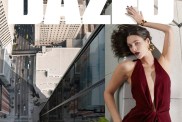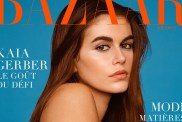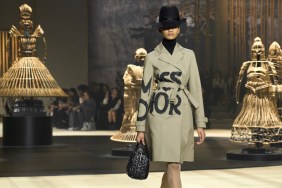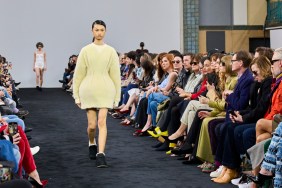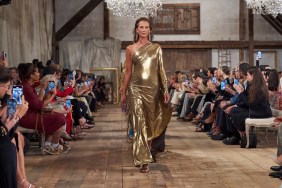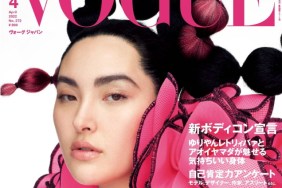Denise Bidot is one of the most recognized faces in the modeling world right now and although she never envisioned this career path for herself, the 30-year-old beauty is embracing her moment in the spotlight and using it to empower others. Denise grew up in Miami with a Kuwaiti father and Puerto Rican mother and moved to Los Angeles at the age of 18 with dreams of becoming an actress. Along the way, the self-confident young woman didn’t compromise her beliefs for the sake of landing a role and little did she know that fate had different plans for her.
Denise’s backup plan of working as a makeup artist essentially led her to become a plus-size model just as a positive body image was becoming the topic of conversation thanks to social media. While she never planned on being a part of the fashion industry, she welcomed it with open arms and a positive attitude — and has never looked back. During her 10 years in the business, Denise has broken barriers, not just by walking the runways of New York Fashion Week and appearing in major campaigns for brands like Lane Bryant, Forever 21, Nordstrom and Levi’s, but by inspiring others to love themselves as they are.
Her confidence is infectious and her fearlessness is inspiring, so it comes as no surprise that the model would want to spread the word of self-love with a campaign of her own called “There is No Wrong Way to be a Woman.” It’s a phrase Denise has often talked about proudly and she’s using it to encourage others to live unapologetically, the way she has throughout her career. We caught up with Denise to talk all things body image, career and the #NoWrongWay movement.

Image: D Dipasupil/WireImage/Getty Images
theFashionSpot: How did you get your start in the modeling industry?
Denise Bidot: I started acting when I was 12. Growing up, I always knew I wanted to be a part of the entertainment industry, but because I wasn’t petite or tall, there was never a thought in my mind that I would become a model. It’s kind of ironic because when I moved to L.A. when I was 18, I thought, “I have talent, I can do this” and I faced a harsh reality because I think the industry was in a different place. I wasn’t getting any acting jobs, not because of my [lack of] talent, but because of my size. I was very disappointed and I remember thinking to myself — because I watched my mom struggle with her weight — “I feel beautiful in my skin, why can’t I be accepted as I am?” I was kind of the rebel in that I didn’t change every time someone told me to lose 10 or 15 pounds. I said, “Nope! Take it or leave it.”
So, I got into makeup to work behind the scenes. I went to [beauty] school and was doing makeup for a plus-size model when I got scouted. The photographer asked me if I had ever thought about modeling and I thought it was a joke because I never even knew that industry existed. I thought to myself, “What? I can model at my size and people will accept that?” I’m short — I’m 5 feet 8 inches — I’m not a size zero, so when the opportunities started coming I was not only flattered, but I thought it was such an amazing chance to do something outside of the box. It’s been 10 years now.
tFS: Was it hard to fit into the industry’s idea of how a model should look?
DB: I think it was hard for me to wrap my head around the fact that I could stay at a size 12 or 14 and people would hire me for being confident and feeling good about myself, which was what I kind of struggled with throughout the acting process. I would ask, “Why do we need to put people in categories?” and “Why do we all have to look the same?” So when I was embraced for my individuality and who I was, it was freeing. It was an amazing opportunity that wouldn’t have happened if it wasn’t meant to be, so I ran through that open door. I thought [modeling] was all about traveling and cute clothes — I never imagined it would turn into such a huge movement.
tFS: How has the modeling industry changed throughout your career?
DB: When I started, the industry was nowhere near where it is now. It wasn’t as cool, either — we wore moo moos and ugly clothes. Plus-size models didn’t really have a voice or have representation. We weren’t booking the big jobs — I came in at a moment when the [plus-size modeling] industry was around, but it was not big. I was able to walk at New York Fashion Week, be in front of Anna Wintour on several occasions. These are things that don’t just happen! Not just for plus-size models, but any model. So, it’s amazing to see this happen throughout the past 10 years. All of those opportunities and the fact that I had the chance to be a part of that change still baffles me. It’s crazy.

Image: JP Yim/Getty Images for Chromat
tFS: Do you think social media has played a part in the way people view models of different sizes and races?
DB: Social media has played a huge part in it. When I started, it was the days of Myspace — models didn’t really have a voice then. Social media has allowed everyone to have a voice and have conversations with brands about who they want to see represented. It’s made a huge difference in how clients book models and what we all learn to accept. It’s been wonderful to see the change. We’ve been allowed to be ourselves, be confident and speak our mind through social media and brands are paying attention.
tFS: What’s your take on diversity in the fashion industry?
DB: I think diversity is finally being embraced, but there is still so much room to grow. We have the Latinas, the white girls and the black girls, but I would love to see even more diversity. I want to see everyone from all over the world represented, old or young and just how they are. Whether that means freckles or a gap-tooth smile — just all of those things that make you, you. We’re just touching the tip of the iceberg and I hope people keep pushing for more.
My friend Jillian Mercado just did a Target commercial and I’m so proud of her because she’s in a wheelchair, signed with IMG and she’s such a good person. What she’s doing and what she represents is something that has never happened before and it’s awesome to see her succeed like that. It’s groundbreaking and it’s so important that we continue that progression.
tFS: You were the first plus-size model to be cast for New York Fashion Week. Do you think models should stop being categorized based on size?
DB: Being able to walk at New York Fashion Week and do something that has never been done before, to be Latina and Middle Eastern, it’s not something that’s just because of my size. I try to tell people that we can’t exclude one thing or the other and that’s why my motto, “There is no wrong way to be a woman,” is so true for me.
tFS: What does that mantra mean to you?
DB: For me, it’s not about saying, “You’re size 14, you’re curvy and you have an hourglass body and that’s what makes you beautiful,” because then you end up alienating a whole different type of girl who may not be curvy. Everyone’s different and we need to allow women to be individuals. It’s important to show something different for the younger generation, who is looking at magazines and thinking they’re supposed to look a certain way — because when you sprinkle in a little bit of everything, you end up with something so powerful.

Image: @denisebidot
tFS: Tell us more about the movement you want to push forward based on this mantra.
DB: For so long I’ve said, “There is no wrong way to be a woman,” and I finally decided to make it a movement beyond just saying it. I want to create scholarships, a lane where women can be embraced for being themselves. I launched it at the Puerto Rican Day Parade and it felt like the perfect culmination of everything I’ve worked toward. I’m Latina, I’m Middle Eastern, I’m the face of diversity and the generation that’s mixed and for so long wasn’t told that they fit in. So, here I am and I’m proud of that and where I come from and I want to make sure other women know that they can be beautiful at any size and age, no matter where they come from.
I invited 10 women from different walks of life to be a part of the class of 2016. The youngest of the group was 18 and the oldest was 65. It was so empowering because I got to produce the shoot myself. This isn’t something sponsored or something someone told me to do; I worked hard for this, I funded it and I am proud of it. I’m so happy to put something out there that’s very unapologetic. The women are so beautiful and the whole shoot felt so right, like something I would want to see in magazines. Sometimes you just have to lead by example. I just want to be the person this group can turn to at any point for support because I know what it’s like.
tFS: What does the movement have in store for the future?
DB: I plan on doing this every year and I want to start a scholarship fund where women can support each other because that’s also important. We [women] make the rules and if we compete constantly, we lose the whole point of progression and moving forward. We’re in such a beautiful place as women that I want to further the movement and keep the conversation alive.
tFS: You’re such a positive role model for young women. Who inspires you?
DB: My mom. So many of her struggles were so personal to me and I learned from her mistakes. I love the fact that she allowed me to go through those struggles with her as a single parent, like wanting to lose weight and yo-yo dieting. And she also allowed me to see the beauty in not caring, but no matter what, she always loved me so dearly. I learned through that and I love her to pieces — she is forever my inspiration.


